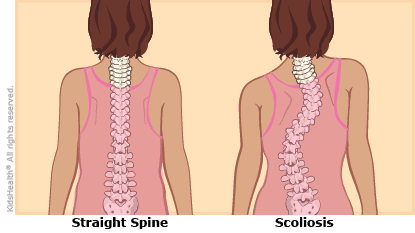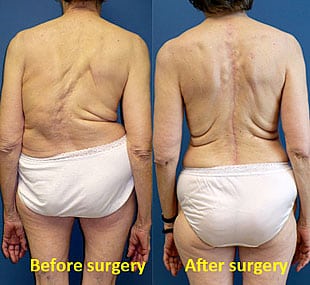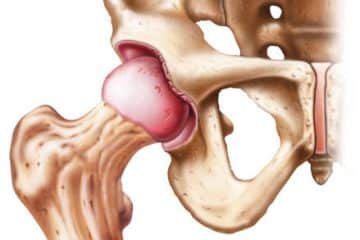Is Scoliosis Surgery Worth It? – Overview
Scoliosis is a medical condition in which the spine is curved sideways. The curve is usually “S” or “C”-shaped. In some, the degree of curve is stable, while in others, it increases over time. Mild scoliosis does not typically cause problems, but severe cases can interfere with breathing. Usually, no pain is present.
Some treatment options for scoliosis include bracing, exercises and surgery.
The brace must be fitted to the person and used daily until growth stops. This tends to prevent scoliosis from getting worse and even correcting the curvature.
If you are wondering if scoliosis surgery is worth it, the answer would be it depends on the degree of curve, location and cause.
Surgery may be recommended if the scoliosis is severe and has a high likelihood of progression and interferes with normal body functions such as breathing.

Causes of Scoliosis
The cause of scoliosis is unknown in about 80% of cases. This is referred to as “idiopathic scoliosis”.
Scoliosis may be due to a birth defect in about 10% of cases. This is referred to as “congenital scoliosis”. The rest of the cases are due to other medical conditions such as:
– Muscular dystrophy
– Spinal cord trauma
– Tumors
– Infections
– Genetic conditions like Marfan syndrome and Down syndrome
Treatment of Scoliosis
The treatment option to be followed for scoliosis depends on the severity of the curvature and its potential to worsen over time. Treatment options include:
- Bracing
- Surgery
Bracing
If the patient has moderate scoliosis and the bones are still growing, the doctor may recommend a brace. This will prevent further curvature, but will not cure or reverse it. Braces are usually worn all the time, even at night. The more hours per day the patient wears the brace, the more effective it tends to be.
The brace does not normally restrict what the child can do. If the child wishes to take part in physical activity, the braces can be taken off.
When the bones stop growing, braces are no longer used. There are two types of braces:
Thoracolumbosacral orthosis (TLSO) – the TLSO is made of plastic and designed to fit neatly around the body’s curves. It is not usually visible under clothing.
Milwaukee brace – this is a full-torso brace and has a neck ring with rests for the chin and the back of the head. This type of brace is only used when the TLSO is not possible or not effective.
One study found that when bracing is used on 10-15-year-olds with idiopathic scoliosis, it reduces the risk of the condition getting worse or needing surgery.
Related: Spinal Fusion Surgery
Surgery
Surgery is usually recommended by orthopedists for curves with a high likelihood of progression (i.e., greater than 45 to 50° of magnitude), curves that would be cosmetically unacceptable as an adult, curves in people with spina bifida and cerebral palsy that interfere with sitting and care, and curves that affect physiological functions such as breathing.[citation needed]
Surgery is indicated by the Society on Scoliosis Orthopaedic and Rehabilitation Treatment (SOSORT) at 45 to 50°[4] and by the Scoliosis Research Society (SRS) at a Cobb angle of 45°.[49] SOSORT uses the 45 to 50° threshold as a result of the well-documented, plus or minus 5° measurement error that can occur while measuring Cobb angles.
Surgeons who are specialized in spine surgery perform surgery for scoliosis. To completely straighten a scoliotic spine is usually impossible, but for the most part, significant corrections are achieved.[50]
The two main types of surgery are:
Anterior fusion: This surgical approach is through an incision at the side of the chest wall.
Posterior fusion: This surgical approach is through an incision on the back and involves the use of metal instrumentation to correct the curve.
One or both of these surgical procedures may be needed. The surgery may be done in one or two stages and, on average, takes four to eight hours.

Scoliosis Surgery Cost
The total cost for scoliosis surgery depends on a lot of factors such as the anesthetic fee, private hospital fee, private operating facility fee, severity of the curvature, location of scoliosis and insurance coverage.
In some cases, scoliosis surgery is considered a cosmetic procedure and as such is not something that is covered by insurance plans. Since each patient’s insurance coverage is different, it’s important to understand your plan to know how much, if any, of the surgery will be covered.
For example, some patients may have high deductibles where insurance will cover only a small portion of the associated costs. On the other hand, some patients may have 80/20 plans where the insurance may cover a significant amount and the patient is only responsible for their copay.
A cost-analysis shared at the International Society for the Advancement of Spine Surgery annual meeting of adult scoliosis surgery found the average total surgical and hospital cost was $47,127. The average total charge was $140,286 and the average total reimbursement was $62,138.
More: Lipoma Removal Cost


